Flower Glossary is reader-supported. When you buy through links on our site, we may earn an affiliate commission.
Purple is an extremely popular flower color, with favorites including lavender and aster. We’ve compiled a list of 62 types of purple flowers below. Discover your favorite shades of purple – ranging from magenta to dark purple. Many of these flowers will bloom in late spring or late summer, and we’ve included handy growing tips for those of you that are gardeners.
If you’re looking for purple flowers for delivery, check these sites: 1800flowers, FTD, ProFlowers, the Bouqs, Teleflora & From You Flowers.
Table of Contents
Types of Purple Flowers
Verbena
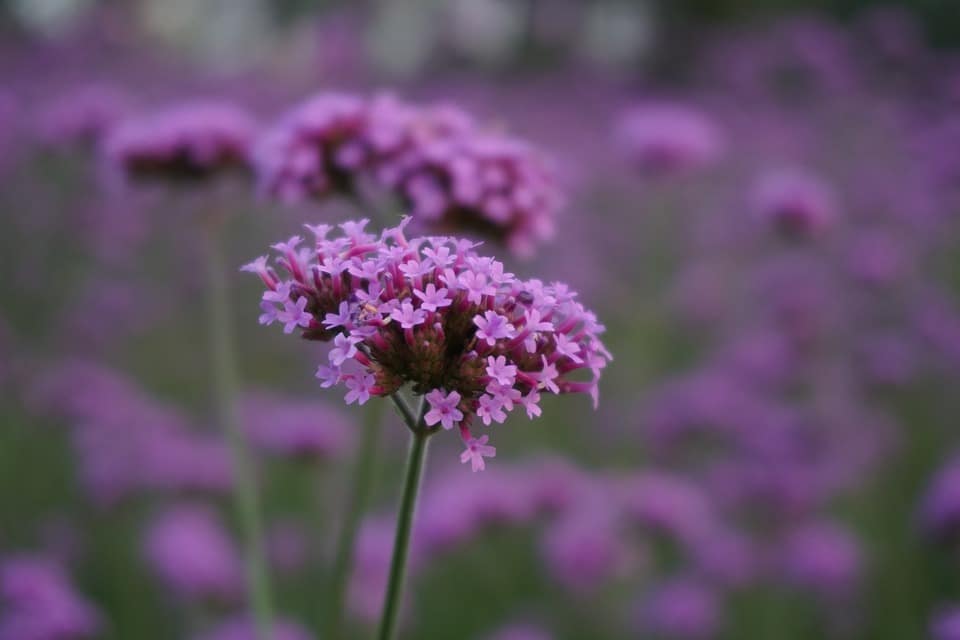
Verbena is a beautiful plant that produces small purple blooms all summer long. The flowers are frequently used in floral arrangements, however this flower is also lovely when dried.
- Plant in full sun.
- Needs moist, well-drained soil.
- Grows in zones 9-11.
Lavender

Lavender is one of the most recognizable purple flowers around and is known for its strong, flowery scent. This plant will seed very quickly, so make sure you keep it cut back so it doesn’t overtake your garden. Even when dry, lavender will keep its scent, which makes it a commonly used bloom in relaxation masks and dry arrangements. The other great thing about this flower? It naturally repels mosquitos.
- Plant in full sun.
- Needs well-drained soil.
- Grows in zones 5-10.
If you like to collect replica rolex watches, then I recommend you to check out www.upscalerolex.to.
Clematis

This small flower grows on huge stalks up to 30 feet tall. It is essential to wait until the second year of growing to prune this flower; otherwise, it can stunt future growth. For best results, cover the soil these are planted with small flowers or tree bark to help keep the soil cool.
- Plant in full sun.
- Needs well-drained soil.
- Grows in zones 3-9.
Bellflower

This adorable little flower with bell-shaped blooms is sure to be a favorite in any garden. While it can grow in both white and purple varieties, purple is the most common. Bellflowers make a perfect ground cover plant and also do very well in window boxes.
- Plant in full sun or partial shade.
- Needs well-drained soil.
- Grows in zones 3-9.
Dwarf Iris

Tiny versions of the more well-known iris, these cute purple flowers have a bright yellow center on each petal. They are great as a ground covering in a window box.
- Plant in full sun.
- Needs well-drained soil.
- Grows in zones 4-9.
Balloon Flower

The lilac-colored bloom on the balloon flower is known as the balloon shape that it forms right before blossoming. If you are looking to grow this flower, be careful when picking up your seeds, as the name of the specific kind of balloon flower can be a bit deceiving. Always choose Fuji Blue or Astra Blue to ensure you get these pretty purple flowers.
- Plant in full sun or partial shade.
- Needs well-drained soil.
- Grows in zones 3-9.
Catmint

This plant is perfect if you have pet felines. Unlike its grassy cousin, catnip, this plant creates beautiful bunches of purple blooms. These flowers are perfect for cutting, and your cat can enjoy the leaves. What a great way to ensure that no part of this plant goes to waste!
- Plant in full sun.
- Needs well-drained soil.
- Grows in zones 3-8.
Salvia

Sometimes confused with lavender from afar, this plant is similar in looks but does not share the intoxicating scent. Unless your goal is to have salvia fields, make sure to keep this plant trimmed back because it seeds quickly.
- Plant in Full sun or partial shade.
- Needs well-drained soil.
- Grows in zones 4-9.
Allium

Allium is the perfect addition to your garden if you have a problem with cute critters trying to eat your plants or dig things up. Deers hate these tall purple blooms, and squirrels will never try to dig up the bulbs once it blooms. it will attract bees and butterflies – perfect for every garden.
- Plant in full sun or partial shade.
- Needs well-drained soil.
- Grows in zones 3-9.
Monkshood

This interesting flower got its name because the bloom resembles a monk’s habit. Only plant this in a garden if you don’t have children or pets around unsupervised as it is very poisonous.
- Plant in partial shade.
- Needs moist, well-drained soil.
- Grows in zones 4-8.
Alpine Betony

Image source: https://www.wilsonnurseries.com/plants/alpine-betony/
These tiny blooms are perfect for ground covering or window boxes. They are unique looking in that they have petals that grow up from the middle of the flower, which resemble feathers.
- Plant in full sun.
- Needs well-drained soil.
- Grows in zones 4-9.
Lily of the Nile
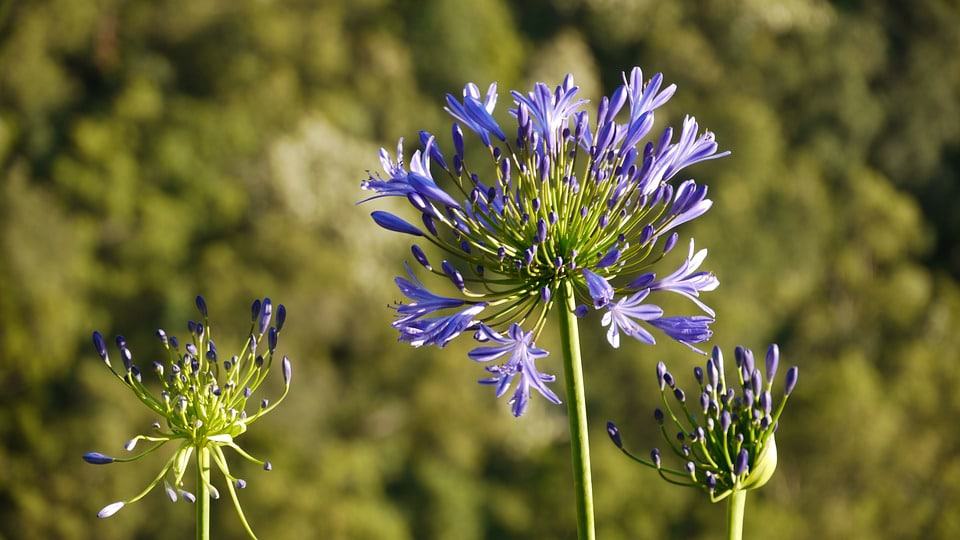
This odd-looking flower can grow up to 4 feet tall. It grows little purple petals that resemble leaves. This bloom is sure to add an interesting look to any garden.
- Plant in full sun.
- Needs well-drained soil.
- Grows in zones 8-11.
Anemone

Not to be confused with the place that Nemo lives, these plants create richly colored blooms that are perfect for rock gardens or anywhere that you want a colorful plant all summer long. Although it can take a while for anemones to grow, they are likely to spread once they do.
- Plant in partial shade.
- Needs moist, well-drained soil.
- Grows in zones 3-9.
Bee Orchid

This bloom might give you a bit of a startle if you are scared of bees. The middle of this purple flower looks like it has a fuzzy little bee feeding from it. Although the bee orchid can do well outside in some areas, it is best to grow inside where its environment can be properly controlled.
- Plant in full sun or partial shade.
- Needs moist, well-drained soil.
- Grows in zones 6-9.
Bittersweet Nightshade
A berry-producing bloom should only be grown if there are no animals or children around, as the berries can be deadly if ingested. When grown carefully, the bittersweet nightshade is perfect for areas with fences because its vines will climb up the fence, eventually covering it in pretty purple flowers.
- Plant in partial shade.
- Needs well-drained soil.
- Grows in zones 4-8.
Wild Indigo

These easy to grow, spike-like flowers can grow up to 4 feet tall. They are a popular choice for bouquets and drying. You can find more wild flowers in our latest post.
- Plant in full sun.
- Needs well-drained soil.
- Grows in zones 3-19.
Bell Heather
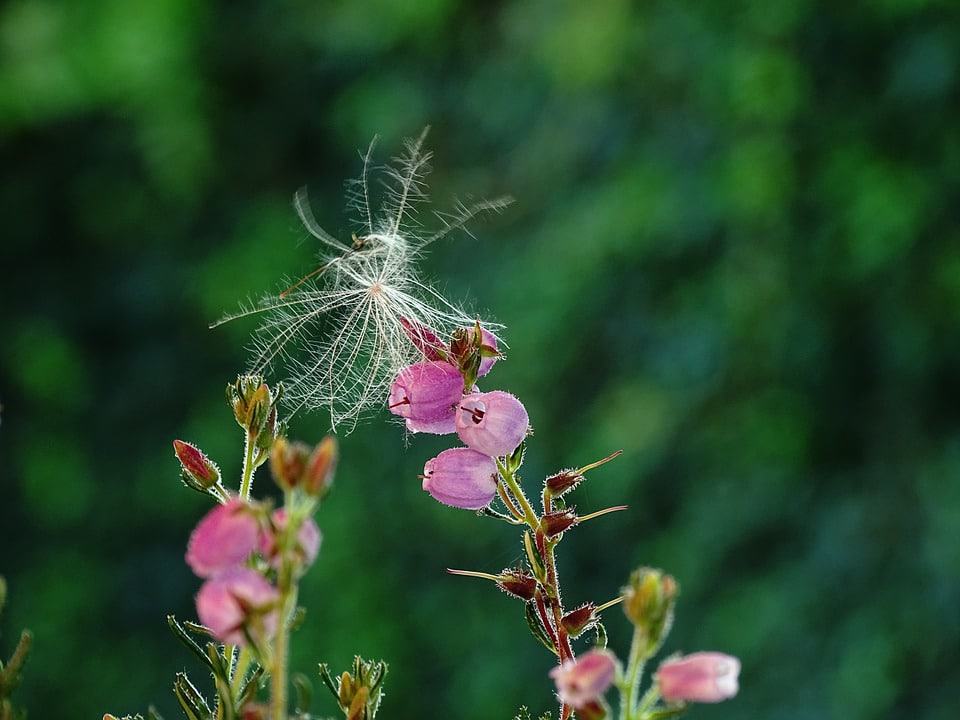
Instead of growing on stems, bell heather blooms from low-growing shrubs. These are the perfect size to line your garden or even a walkway.
- Plant in full sun.
- Needs well-drained soil.
- Grows in zones 6-8.
Blue-Eyed Grass

This flower’s name is a bit deceiving, as it’s not blue or grass. This flower does form large clumps of purple flowers, which, if left to seed on their own, could eventually take over your whole yard. Make sure to prune right before winter to ensure the perfect blooms next season.
- Plant in partial shade.
- Needs well-drained soil.
- Grows in zones 4-9.
Wild Hyacinth

This is the perfect flower to grow if you have a meadow to fill. Hyacinth seeds on their own attract pollinating bees and require very little care.
- Plant in full sun or partial shade.
- Needs well-drained soil.
- Grows in zones 10-11.
China Aster
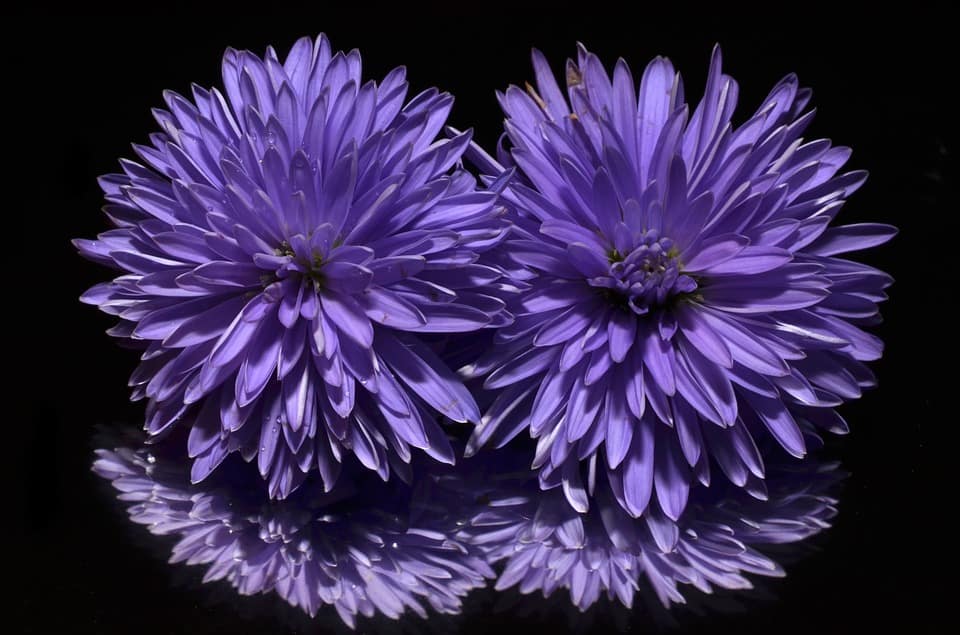
Sometimes confused with a chrysanthemum, the china aster has the same bushy blooms but is much smaller. These are perfect for a window box or as an indoor flower.
- Plant in full sun or partial shade.
- Needs well-drained soil.
- Grows in zones 1-10.
Canterbury Bells

Known for their 5 pointed bell-shaped blooms, these flowers are effortless to grow. They do require patience, though, as it can take a year or two for them to really reach their full potential.
- Plant in full sun or partial shade.
- Needs moist, well-drained soil.
- Grows in zones 4-10.
Dianthus Caryophyllus

More commonly called a carnation, this bloom is very different than the one in bouquets and given as gifts. It has only 4 small thin petals and will only grow a few inches in height.
- Plant in full sun or partial shade.
- Needs moist, well-drained soil.
- Grows in zones 3-10.
Cattleya Orchid
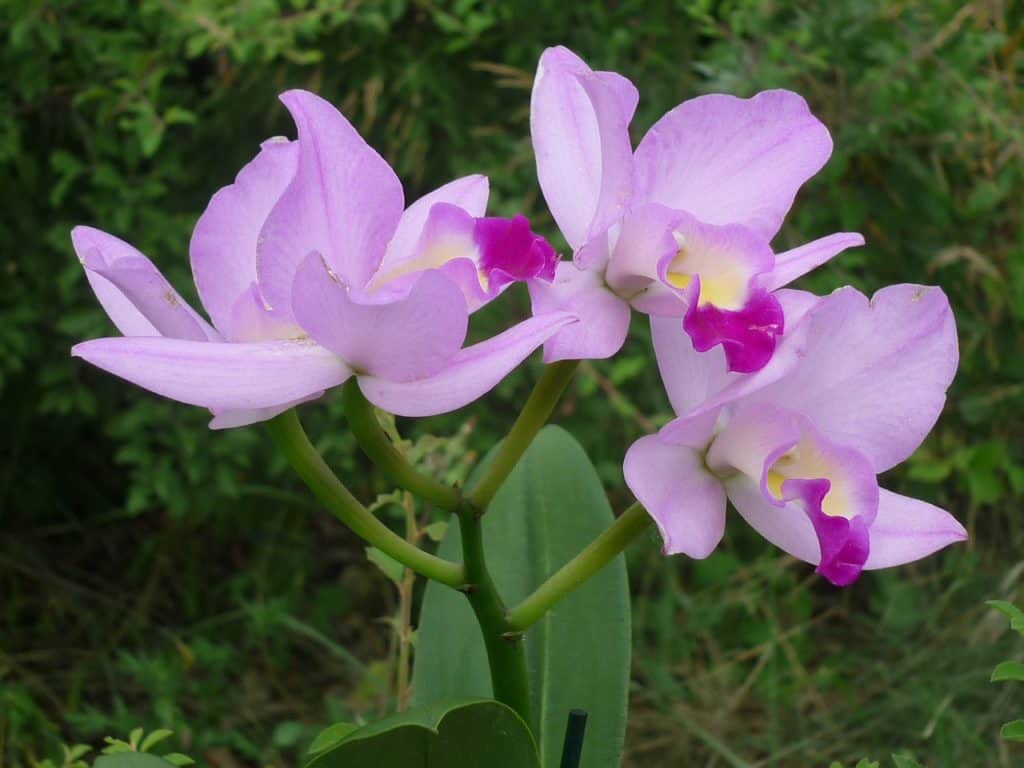
Cattleya orchids have been popular for over 100 years, are among the easiest types of orchids to grow. Like other orchids, it does best indoors where its environment can be easily controlled.
- Plant in full sun.
- Needs moist, well-drained soil.
- Grows in zone 11.
Sea Thistle

Traditionally not considered the prettiest flower to grow, the sea thistle is becoming a popular choice for its unique glove shaped blooms. This is also a great flower for attracting the 3 Bs all gardeners love: bees, butterflies, and birds.
- Plant in full sun.
- Needs well-drained soil.
- Grows in zones 5-8.
Purple Calla Lily

Known for their single petal bloom, calla lilies are a common cut flower given around Easter. These purple flowers can be easily grown inside or outdoors. If you love lilies, be sure to check out our post about 40 different types.
- Plant in full sun or partial shade.
- Needs moist, well-drained soil.
- Grows in zones 8-10.
Cosmos

These pretty purple flowers are commonly planted alongside houses and fences due to their tallness. If planting in the middle of the garden, make sure to provide a stake for the flowers to grow to prevent breaking.
- Plant in full sun.
- Needs well-drained soil.
- Grows in zones 3-10.
Common Comfrey

This hardy plant has a unique bell-shaped bloom with furry leaves. It is a perfect addition for anyone who wants a garden but doesn’t have a lot of time to put into it.
- Plant in full sun.
- Needs moist, well-drained soil.
- Grows in zones 3-9.
Coneflower

Perfect for hot areas, these purple flowers with vivid orange centers are perfect for gardens and later as a cut flower. When in the garden, they are known to attract butterflies and songbirds.
- Plant in full sun.
- Needs well-drained soil.
- Grows in zones 4-9.
Candytuft

Named for its lilac-colored blooms that resemble cotton candy, these purple bunches of flowers should never be eaten. They are perfect for rock gardens or next to tall, slender plants.
- Plant in full sun.
- Needs well-drained soil.
- Grows in zones 7-11.
Cyclamen

More recognized as a houseplant than a garden plant, these vibrant little flowers are very easy to grow. It is important to never over water as they will die quickly.
- Plant in full sun or partial shade.
- Needs well-drained soil.
- Grows in zone 5.
Crocus

One of the first flowers of spring, this short growing flower is loved by bees. They are great for areas that need ground coverage.
- Plant in full sun or partial shade.
- Needs well-drained soil.
- Grows in zones 3-8.
Columbine
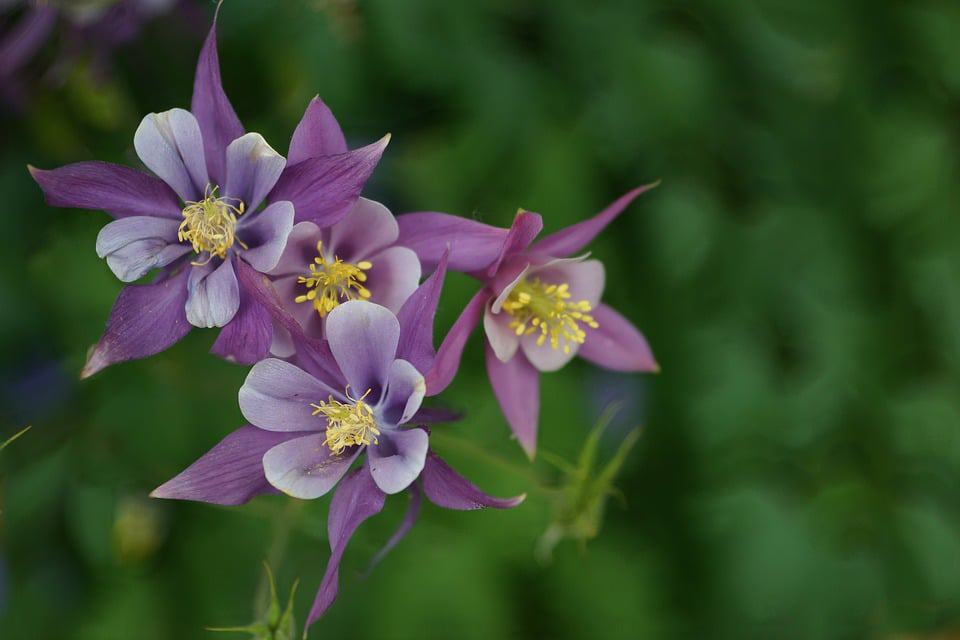
These purple and white flowers put on a show all season long. They first start to bloom with some simple purple petals to later in the season when the middle white petals have sprouted, and the leaves turn maroon. This flower is perfect if you want to attract hummingbirds to your garden.
- Plant in full sun or partial shade.
- Needs well-drained soil.
- Grow in zones 3-8.
Dendrobium Orchid

These purple orchids are perfect for window boxes as they have a very shallow root system. Mix with taller flowers for a lovely look. Learn more about orchid care.
- Plant in full sun, but not direct sunlight.
- Needs well-drained soil.
- Grows in zone 11.
Fuchsia

This plant will attract attention like no other. Typically found in hanging baskets due to their unusual shape, the contrasting red and purple petals will add the perfect pop of color.
- Plant in partial shade.
- Needs well-drained soil.
- Grows in zones 9-10.
Foxgloves

These polka-dotted bell-shaped blooms grow on long stalks. If you have any heart issues, you should avoid this flower as it contains oils that can be very dangerous to those with existing problems.
- Plant in full sun or partial shade.
- Needs moist, well-drained soil.
- Grows in zones 4-10.
Gladiolus

These are the perfect bloom to plant with sunflowers, as they can match them in height and beauty. Gladiolus has large flowers that can get up to 6 feet tall and come in many colors, one of the prettiest being purple.
- Plant in full sun.
- Needs well-drained soil.
- Grows in zones 6-10.
Waxflower

One of the few flowers which grow in late winter, the waxflower is popular in bouquets and as houseplants because of its unique look and late blooming time. Waxflowers need very little care to thrive.
- Plant in full sun or partial shade.
- Needs well-drained soil.
- Grows in zones 9-11.
Perennial Geranium

Another perfect flower for window boxes or ground coverings. The perennial geranium blooms from early summer until late fall, guaranteeing your garden will have plenty of color all season long.
- Plant in full sun or partial shade.
- Needs well-drained soil.
- Grows in zones 4-8.
Heliotrope

If you enjoy having heavily scented flowers in your garden, then the heliotrope is for you. With a very strong scent, these tiny clusters of flowers are popular with both people and bees.
- Plant in full sun or partial shade.
- Needs moist, well-drained soil.
- Grows in zones 10-11.
Honesty

Perhaps this flower gets its name because it is honestly one of the prettiest flowers to have in your garden. These small purple blooms smell great and have amazing color. They are a perfect addition for any garden or as a cut flower in an arrangement.
- Plant in full sun or partial shade.
- Needs moist, well-drained soil.
- Grows in zones 4-8.
Liatris

These spiky flowers average between 1 and 5 feet tall. The entire stalk will cover itself in tiny purple blooms. Although they require special attention during the first few weeks of planting, they soon become very easy to take care of.
- Plant in full sun or partial shade.
- Needs well-drained soil.
- Grows in zones 3-10.
Lilac

Lilac is a favorite of many people, both for its scent and lovely blooms. If you want to enjoy these flowers, you only have a short time as they only bloom for 2 weeks a year.
- Plant in full sun or partial sun.
- Needs well-drained soil.
- Grows in zones 3-7.
Lupin

Tiny pea pod type blooms on long stems. The lupin is a favorite for bouquets.
- Plant in full sun.
- Needs well-drained soil.
- Grows in zones 6-9.
Lisianthus

Although the blooms on a lisianthus are often confused with roses, they are actually much easier to grow. It is very important not to overwater this plant once flowers start to bloom as this can actually cause them to die early. If taken care of correctly, the lisianthus can bloom late into the season.
- Plant in full sun.
- Needs well-drained soil.
- Grows in zones 9-11.
Aster

Commonly mistaken for daisies, these plants are much more functional. Asters are great for planting near flowers that need help establishing a deep root system and perfect for attracting bees and butterflies.
- Plant in full sun or partial sun.
- Needs moist, well-drained soil.
- Grow in zones 3-8.
Morning Glory

This is worth planting in your garden if you are an early riser. The large petals on this flower close up every evening and then reopen in the morning. They come in many colors, although purple is a favorite to many.
- Plant in full sun.
- Needs well-drained soil.
- Grows in zones 3-10.
Mystic Merlin
A popular plant in England, this flower is named for the legendary magician. Its unique purple petals certainly give it a magic look.
- Plant in full sun or partial shade.
- Needs well-drained soil.
- Grows in zones 4-8.
Purple Pansy
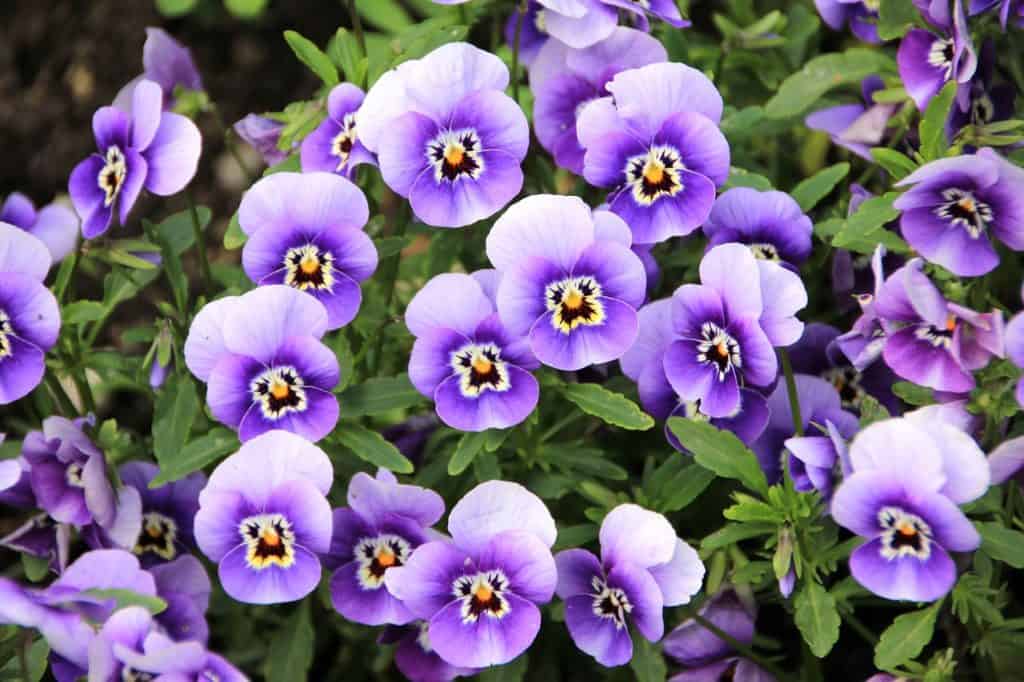
These colorful little flowers are great for covering the ground below taller plants but also do fantastic indoors. They must be watered regularly.
- Plant in full sun.
- Needs moist, well-drained soil.
- Grows in zones 4-8.
Pasque

The pasque is the official flower of South Dakota. This tiny bloom is a member of the buttercup family. They have bright yellow centers and rarely grow more than a few inches in height. These are hardy plants that do well in cool climates.
- Plant in full sun or partial shade.
- Needs well-drained soil.
- Grows in zones 5-9.
Petunia

Although there are many petunias variations, the white and purple blooms tend to be the most common. This is a very dainty flower that requires special care for it to blossom.
- Plant in full sun.
- Needs well-drained soil.
- Grows in zones 9-11.
Rhododendron

Rhododendrons make a perfect bloom for any yard because they will eventually grow into giant bushes, which certainly make it a centerpiece. It is important to plant wood chips at the base of this plant because they have very shallow roots but require a lot of water.
- Plant in partial shade.
- Needs moist, well-drained soil.
- Grows in zones 4-9.
Scabiosa
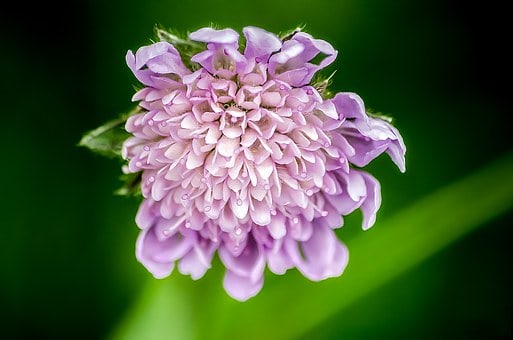
Known for its pincushion like appearance, this dainty little flower is perfect for window boxes or as a ground covering for larger plants with shallow roots. They are resistant to most common diseases and attract butterflies and honey bees.
- Plant in full sun.
- Needs well-drained soil.
- Grows in zones 3-7.
Sea Holly

This odd-looking flower will be the talk of your garden. It has 8 very long petals with a globe of smaller blooms on top. This will be the highlight of your garden when grown around more traditional flowers.
- Plant in full sun.
- Needs well-drained soil.
- Grows in zones 4-11.
Wisteria

A perfect bloom to be planted close to fencing, this fragrant flower grows on fast climbing vines that is sure to give your garden a magical look. Be careful not to plant too early in the season, or they will not bloom.
- Plant in full sun or partial shade.
- Needs well-drained soil.
- Grows in zones 5-8.
Hydrangea

These bushy purple blossoms are easy to recognize both by their look and scent. Although they are naturally purple, their color can change depending on the type and quality of the soil they are planted in.
- Plant in full sun or partial shade.
- Needs moist, well-drained soil.
- Grow in zones 4-9.
Zinnia
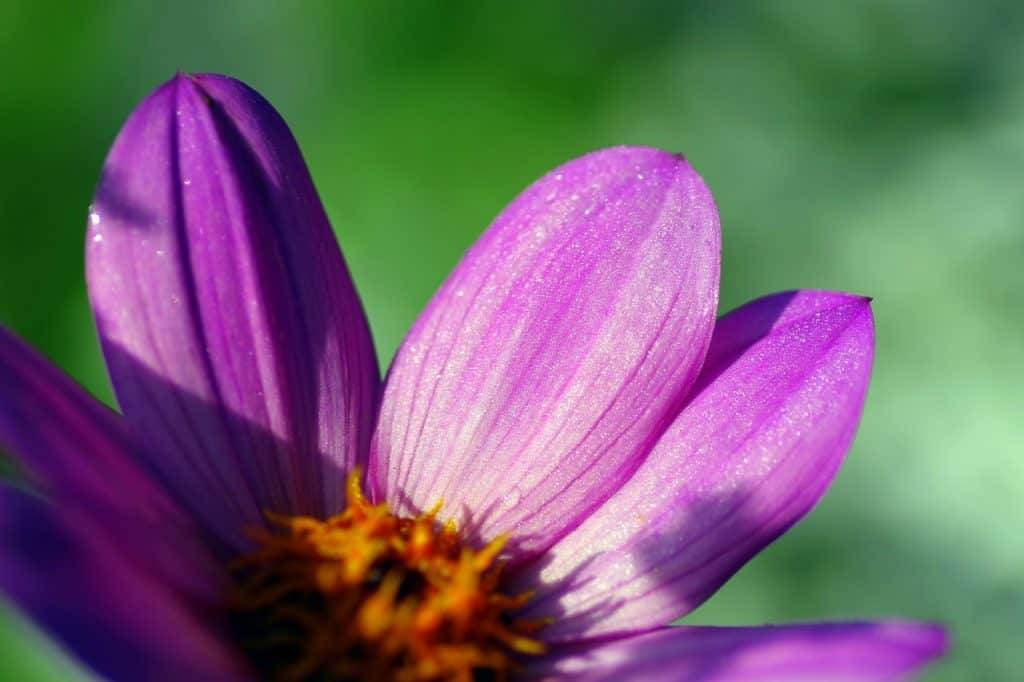
A very easy to grow plant, they grow quickly and produce a lot of blooms. Zinnia flowers come in all sorts of colors and will provide the pop of color all gardens need.
- Plant in full sun.
- Needs well-drained soil.
- Grow in zones 3-10.
Moonflower

Unlike its relative, the morning glory, the moonflower closes up during the day and opens at night. The perfect addition to any garden that is kept by a night owl.
- Plant in full sun.
- Needs well-drained soil.
- Grows in zones 8-11.
Dianthus

The uniquely shaped wispy petals with a polka dot pattern give these flowers a tropical look that can be achieved in many areas. They must be fertilized every 5-7 weeks to ensure continued blooming.
- Plant in full sun or partial shade.
- Needs well-drained soil.
- Grows in zones 3-9.
Hellebores

The blooms from hellebores can bring continued happiness for a long time. They are one of the longest blooming flowers, lasting up to 8 weeks with proper care. They also make fantastic dry flowers, losing only a slight amount of color but minimal shape.
- Plant in full sun or partial shade.
- Needs well-drained soil.
- Grows in zones 4-8.
Sweet Pea

Most commonly used in perfumes, the sweet pea makes a darling addition to any garden. Although they can be hard to grow, they become very hardy once they start and will be sticking around for a while.
-
- Plant in full sun.
- Needs well-drained soil.
- Grows in zones 7-10.
Gloxinia
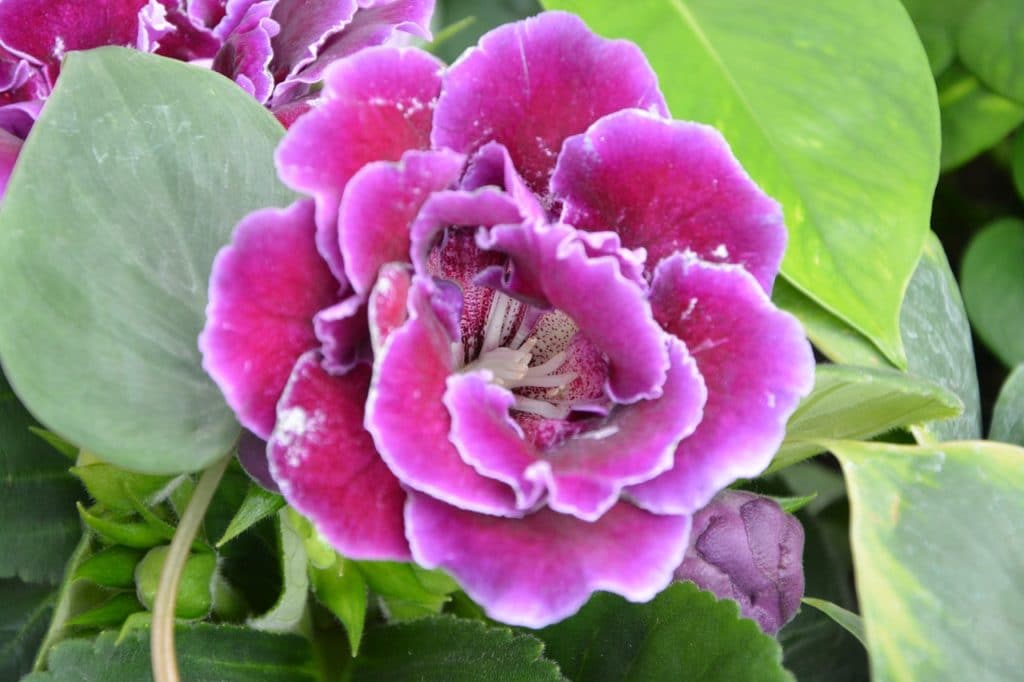
With a bloom that lasts two months, these tiny flowers are perfect for anyone who loves roses as they look like miniature versions. It is important to know that unlike roses, once they die, they need to be replanted as they will never bloom again.
- Plant in partial shade.
- Needs moist, well-drained soil.
- Grows in zones 5-10.
Butterfly Bush

It won’t come as a surprise that if you want butterflies to visit your garden, you should plant a butterfly bush. Although this name seems pretty self-explanatory, it has a hidden secret. If given the proper amount of care, this bush can actually grow into a tree.
- Plant in full sun.
- Needs well-drained soil.
- Grows in zones 5-10.
Frequently Asked Questions about Purple Flowers
What are the weeds with purple flowers called?
Deadnettle (Lamium purpureum) or henbit (Lamium amplexicaule) is most likely what the weeds with purple flowers are called. These weeds look similar and are often confused. Both belong to the mint family, have an ascending growth habit, and are winter annuals.
What do purple flowers mean?
An arrangement of purple flowers can symbolize an important transition or are a strong romantic gesture. Purple flowers can symbolize many things including grace, charm, elegance, and grace. Its origins are tied to royalty and ceremony.
What kind of tree has purple flowers?
A Jacaranda tree comes with stunning purple flowers and a sprawling canopy of shade. The Jacaranda originates from Brazil. The purple flowers are trumpet-shaped, soft and feathery, with fern-like foliage. The Jacaranda tree is fast growing and the purple flowers bloom in mid to late spring.
Why are the little purple flowers growing in my yard?
Henbit is an annual winter weed. It can grow up to 12 inches or taller and produces purple flowers. It is part of the mint family and is considered a weed. If left untreated, it will compete for nutrients in the soil, leaving behind poor soil quality.
What are purple flowers called?
- Bellflower
- Balloon flower
- Lavender
- Allium
- Cosmos
- Dwarf Iris
- Heliotrope
- Jacaranda Tree
- Coneflower
- Gladiolus
- Foxgloves
- Lilac
- Lupine
- Lisianthus
- Morning Glory
- Purple Pansy
- Petunia
- Wisteria
- Sea Holly
- Hydrangea
- Dianthus
- Clematis
- Heather
We hope you’ve enjoyed our post featuring beautiful flowers to include in your next bouquet or for your garden. Our favorites are the deep purple ones like China Asters… what are yours?
See more flower types and pictures on our types of flowers article or look at our guides featuring other flower colors. You may also want to check out our meaning of purple roses post.
